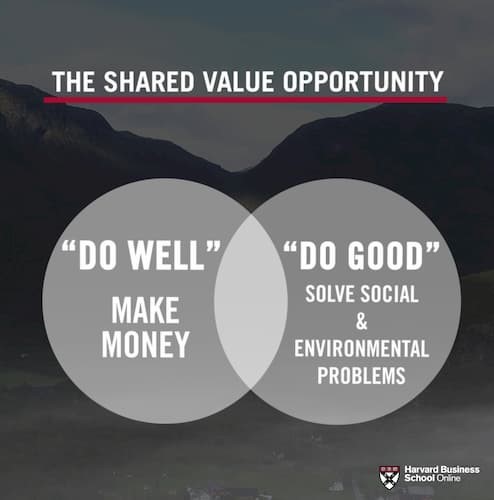Last month during our Positive Economics series, we focused on “Understanding Fiscal Policy” from a governmental point of view. Click here for the recording and other resources. During tonight’s Positive Economics webinar, we discussed how business interacts with sustainability through asking the following questions:
How do businesses interact with sustainability?
Let’s start with a specific example and then move into the general. In our own case here, we’ve worked on several on the Sustainable Development Goals including “Provide Quality Education”, “Gender Equality”, “Good Jobs and Economic Growth”, “Innovation and Infrastructure” and “Partnerships for the Goals”. All of the details are contained in this infographic.
To look at this picture nationally, it’s worthwhile to look at the Sustainable Development Goals Champions. There are several examples of companies who are seeking to lead the charge and act as role models in their industry and the country.

Source: Online Harvard Business School
Why is it beneficial for companies to be more sustainable?
There is lots of data available today describing how beneficial it so for companies to pursue the “triple bottom line” of people, planet and profit. The Harvard Business School Online abounds with examples of individual companies and a plethora of statistics. Closer to home, in their Retail Consumer Insights Report, PwC Ireland relays that “In addition, two-thirds of the Irish sample is willing to pay for locally produced food items, and 41% say they will pay more for sustainably produced non-food items.” Therefore, consumers are demanding more sustainably produced products and services. In fact, we ran a poll tonight among the hundreds of attendees to conduct some primary research. We learned that 85% of the people in attendance would pay a premium for sustainably produced products, which confirms that trend.
What holds businesses back from being more sustainable?
Whilst we can certainly argue that sustainability is good for business, there are many companies that don’t act that way. One way we can seek to understand this is through Carroll’s Pyramid of CSR.

Source: The CSR Journal
In essence, this model that a company needs to be profitable first so that it can meet its debts and obligations as well as reliably provide its goods and services to others. Next, it needs to obey the law i.e. pay at least, or above, minimum wages to its staff. It needs to pay and file its taxes on time. It needs to ensure that its property is safe for customers and staff, etc. Next, it has ethical responsibility. In other words, it must do the right thing. Rather than just offer good pay and working conditions, the ethical thing to do is take care of its staff well by offering them good learning opportunities, possibilities for opportunities and a happy place to work. At the top of the pyramid, it has the responsibility to be a good citizen by giving back to the community (and this loops us back to the Sustainable Development Goals as examples). Therefore, a company can’t sponsor the local GAA team if it doesn’t have the money to pay its taxes. We looked at the challenges the fashion industry faces in abating its carbon emissions.
What is the impact of COVID on sustainability?
In the Economic Research Project Brief, there is a clear statement “The Covid-19 crisis has revealed a number of critical challenges in relation to Ireland’s economic, environmental and social sustainability”. Specifically, the project directs students to the NESC website as it offers a range of ways that Ireland has changed through the impact of the crisis as well as how it has affected how we can consider new ways to live and consume sustainably including:
- To explore economic and societal shifts from the crisis;
- To urgently reduce emissions to meet 2030 targets while also stimulating the economy;
- To invest in local economy and community responses, the circular economy, bioeconomy, flexible working, and sustainable mobility;
- To co-build local economies through community wealth measures, social contracts, and community energy etc.;
- To further enhance Ireland’s natural habitats, air quality and ecosystems, which are anecdotally enhanced by our reduced presence and activity; and
- To carefully review remote working practices to ensure everyone can benefit.
Finally, we discussed the newly published Digital Completion Booklet. I offered some thoughts for working through the document including:
- Write the title after you decide on the individual line of enquiry and structure it afterwards i.e. “An investigation into the connection between…”
- The line of enquiry needs to describe in one line what you want to do. Pick something that you’re interested in and enjoy.
- Find your reliable sources early! If you have these from good solid resources, you can build other secondary research or new primary research around them.
- Use Google Charts or “Insert Chart” on PowerPoint to create graphs.
- Go back to your original line of enquiry and aims when concluding so that you can demonstrate coherence.
- Keep a journal along the way and write a couple of lines of your experience every time you work on the project. This will help you articulate your reflections.
- It’s key to share what have you learned about the economic theory.
Join us next month for the next Positive Economics webinar focusing on “Elasticity and Individual Consumption” on Monday 30th November. Click here to register.